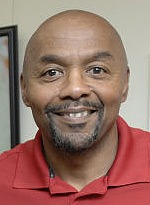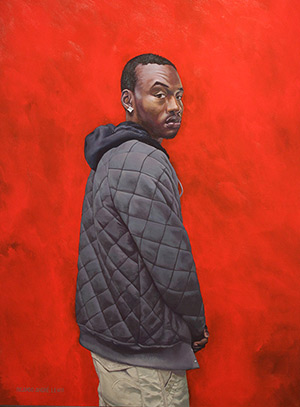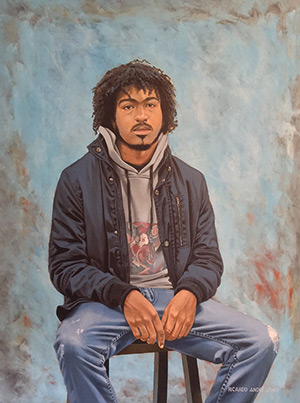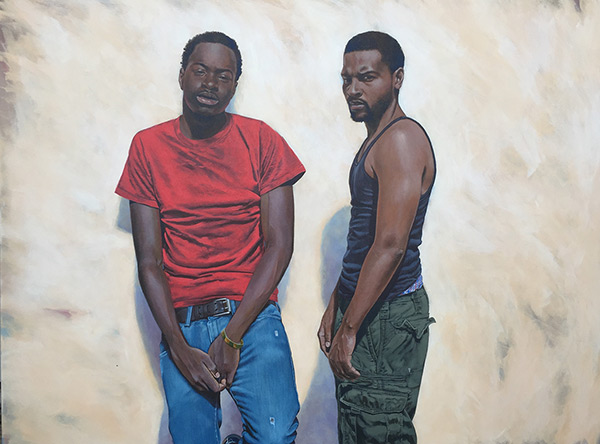 Ricardo Andre' Lewis realized his passion for art in high school and came to Illinois in 1985. He received his M.S. in Art from Illinois State University in 1987 and currently serves as the Associate Dean of Students for the university. Lewis specializes in paintings and his current body of work is portraits of African American male students from Illinois State University. Read on to learn more about Mr. Lewis and check out his website for more information about his work.
Ricardo Andre' Lewis realized his passion for art in high school and came to Illinois in 1985. He received his M.S. in Art from Illinois State University in 1987 and currently serves as the Associate Dean of Students for the university. Lewis specializes in paintings and his current body of work is portraits of African American male students from Illinois State University. Read on to learn more about Mr. Lewis and check out his website for more information about his work.
ILI: How long have you been an artist or when did you start? Was there a single incident or moment when you realized this was your passion and if so, tell us about it?
 LEWIS: Growing up in segregated communities in North Carolina in the 1960s, we were not exposed to formal art. My interest in art originated with drawing cartoons and comic book heroes in elementary school. Kids would pay me quarters for drawings. My biggest dream was drawing “Bambi” from the Art Instruction School advertisement, believing I’d be selected to participate in the program never realizing it was a program where you completed assignments that you’d mail in for evaluation. I was naïve.
LEWIS: Growing up in segregated communities in North Carolina in the 1960s, we were not exposed to formal art. My interest in art originated with drawing cartoons and comic book heroes in elementary school. Kids would pay me quarters for drawings. My biggest dream was drawing “Bambi” from the Art Instruction School advertisement, believing I’d be selected to participate in the program never realizing it was a program where you completed assignments that you’d mail in for evaluation. I was naïve.
I realized my passion for art in high school, where I learned to paint and was heavily influenced by the regional genre of rural landscape. My parents could not afford to send me to college so a college degree in art was not my aspiration.
After graduating from high school with no job or career goals, I ventured to the HR department at Wake Forest University to apply for a job in grounds. There were no jobs available in grounds but a job as an animal caretaker was open. The professor who hired me, Dr. Raymond E. Kuhn, invited me to his office a few weeks into the job to get to know me and inquired about my interest and hobbies. When I told him drawing and painting he asked to see samples of my work. When I brought a few examples to his office, he was impressed, purchased two paintings on the spot and asked, “Why aren’t you in college?” He helped me enroll at Winston-Salem State University and mentored me over the next four years.
 ILI: Illinois has been factored into your work in the past. What does being able to live and work in Illinois mean to you?
ILI: Illinois has been factored into your work in the past. What does being able to live and work in Illinois mean to you?
LEWIS: I was lucky to even land in Illinois in 1985. Dr. Kuhn again urged me to pursue an advanced degree and since this was pre-Internet, I had no way of researching the different master’s programs in art. I wrote the names of states on slips of paper and placed these in a hat. When I drew the state of Illinois, I applied to Illinois State University and was accepted. What convinced me that I had made the right choice in Illinois State was the irony of meeting retired art faculty Dr. William Colvin. Dr. Colvin invited another art student and me to his home for dinner and during the conversation we discovered we all studied under the same art professor, Dr. Hayward Oubre, at our different undergraduate institutions. In my master’s program, I studied under wonderful artists such as Dr. Harold Gregor and Ken Holder. Illinois State hired me as an administrator after I graduated in 1987, and I made Illinois home taking advantage of the vibrant community in Bloomington-Normal and the proximity to Chicago and St. Louis to expose myself to a variety of visual and performing arts.
My current body of work is portraits of African American male students from Illinois State. Because the works do not offer visual cues and context in the presentation of the figures, the viewer is left to engage the work with what they bring to the experience and how they have been socialized regarding African American males and race. My models are mostly residents of the Chicago area with an exception of two from outside Illinois, but each of them share the same experiences of micro-aggressions from being African American males. As an African American male artist, I have to filter their life experiences through my artist lens as well as my own experiences with micro-aggressions from previous decades and present the men in such a way that captures the effect of institutionalized racism on their attitudes, posture and demeanor. I am inviting the viewer to challenge their assumptions and stereotypes of this group of men in the absence of narrative.
 ILI: What opportunities does Illinois present to local Illinois artists?
ILI: What opportunities does Illinois present to local Illinois artists?
LEWIS: Illinois is very receptive to the wide array of artistic styles and mediums. It offers a variety of opportunities to local artists because of the diversity in the types of art that is supported in the state as well as an opportunity to place their art in front of a diverse audience.
ILI: What do you like about Illinois?
LEWIS: I love that I can go to local museums, art fairs and college campuses and find affordable and accessible art that addresses every medium and concept in the world. I live in Bloomington-Normal, so between Illinois State, Illinois Wesleyan, local galleries and a variety of festivals, there is no limit to the kinds of art we get exposed to. I’m impressed at the local, regional and international talent we have to offer.
ILI: What is your favorite medium to work in?
LEWIS: My favorite medium is acrylic paint on canvas. I love it for its immediacy and fast drying time. I apply it in glazes like watercolor but only make three to five passes over parts of the painting. I have recently expanded my palette of color choices to have more color in my work.
ILI: Where can people view or purchase your work?
LEWIS: I have not affiliated with any local galleries or associations yet since I’m still working full time at Illinois State, but I invite people to visit my website, ricardoandrelewisart.com, to see my work and my contact information. I also have a link on the website that directs people interested in how my work develops to my blog site where people can see works in progress and read my thoughts and reactions as my work is being created. I have reproductions of earlier works available for purchase upon request.
ILI: What artist inspires you and why?
LEWIS: I’m inspired by artists such as Andrew Wyeth for his regionalist realism, John Singer Sargent as a portrait painter and his technique of “drawing with the brush” and Stephen Scott Young, an artist working in Florida and the Bahamas who paints in watercolor in the style of Wyeth and uses the beautiful Black people of the Bahamas as models with striking contrasts of dark skin against white backgrounds.




